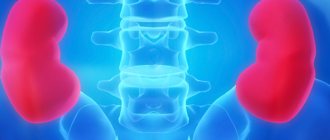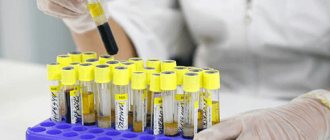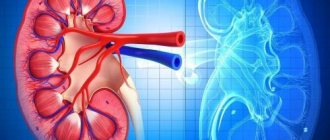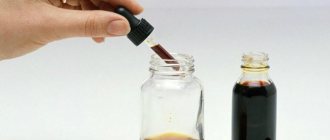An important indicator of a biochemical blood test is creatinine. This amino acid is formed in muscles after the non-enzymatic breakdown of creatine, a substance involved in the energy metabolism of the muscular system. The concentration of creatinine in the blood, with proper functioning of the muscular system and kidneys, is always maintained within certain values.
Deviations from the norm indicate a violation of the process of elimination from the body. The problem arises with kidney pathologies and impaired energy metabolism in the muscles. Understanding what creatinine is in the blood, the doctor can prescribe additional tests to make an accurate diagnosis in order to carry out the correct treatment.
Features of indicators
Creatinine is a substance released when proteins are broken down in muscles. This means that its concentration in the blood is related to various factors. First of all, the normal level of creatinine in the blood depends on a person’s weight and physical activity. As a result, indicators differ between women, men and children. The age factor also affects creatinine in the blood.
When carrying out the analysis, the following standard values in µm/l are taken as a basis:
- For children under one year old – 18-35.
- For children from one year to 14 years old – 27-62.
- For young people from 14 to 18 years old – 44-88.
- For women under 60 years old – 53-97.
- For women over 60 years old – 53-106.
- For men under 60 years old – 80-115.
- For men – 71-115.
Understanding what creatinine is, it can be argued that determining its indicators using a biochemical blood test is exclusively a method of primary diagnosis. If deviations from standard indicators are detected, more accurate diagnostics will be needed in order to confirm or refute certain pathologies.
Increased levels of the substance in the blood
If creatine, the norm of which is indicated in special tables on many medical websites, is slightly increased, then this is not a problem. An increase in the concentration of the substance in the blood is often recorded in athletes, due to a significant amount of muscle mass, as well as in people:
- After severe physical stress.
- Those who eat a large amount of meat products.
- Taking certain medications in the process of treating illnesses.
A significant increase in acceptable values may indicate the development of serious pathologies:
- Kidney. Since creatinine is completely excreted by the kidneys, a large amount of it in the blood may indicate a dysfunction of the organ and the development of renal failure. Indicators increase when one kidney is removed.
- Cardiac system. When the amount of creatinine increases, blood circulation is impaired, which creates a risk of destruction of the heart muscle.
- Endocrine system. When the thyroid gland malfunctions, hormones are produced that destroy muscle tissue, which leads to an increase in the concentration of the substance in the blood.
In the presence of cancer, muscle tissue is also destroyed, which increases the level of creatinine in the blood plasma. The concentration of the substance increases when muscle tissue is injured, but after the condition normalizes, the indicators are restored.
An increase in creatinine levels in the blood is often accompanied by drowsiness, loss of energy and breathing problems. Headache and nausea may also occur. Since the concentration of this amino acid in plasma increases due to the development of pathologies dangerous to health, the root cause must always be treated.
Decreased levels of a substance in the blood
Creatinine, the norm of which in men indicates a good state of the muscular system, with reduced values indicates a discrepancy between body weight and anthropological parameters. The level of the substance in the blood decreases in those who fast for a long time, which leads to atrophy of muscle mass.
Creatinine is reduced in people:
- Suffering from cachexia.
- Amputated limbs.
- Elderly.
Creatinine, the norm in women for this substance also confirms the good condition of the muscular system, may decrease for physiological reasons during pregnancy. This is due to the fact that the urinary system works under increased load. Most often, a decrease in the concentration of the substance is observed in the first trimester.
Creatinine
Creatinine is the end product of the metabolism of creatine phosphate, a substance involved in the mechanisms of quickly meeting the energy needs of muscle contraction.
Creatinine is formed in muscles as a result of the non-enzymatic cleavage of the phosphate group from creatine phosphate, as well as the spontaneous conversion of creatine to creatinine. It is produced and enters the blood at a constant rate, so the concentration of creatinine in the blood serum is relatively stable and is normally determined mainly by the total volume of human muscle mass. In men, the creatinine content is slightly higher compared to women, which is associated with relatively greater muscle mass. Serum creatinine levels depend on age (reference values for children are significantly lower). Blood creatinine concentrations are physiologically reduced in pregnant women (by 40%) due to increased blood volume, increased renal plasma flow and filtration, and a corresponding increase in creatinine clearance, especially in the second and third trimesters of pregnancy.
Creatinine is removed from the blood by the kidneys. It belongs to the so-called “non-threshold” substances: normally, creatinine is freely filtered in the glomeruli and then, without being subjected to reabsorption or additional secretion in the tubules, it is completely excreted in the urine from the body. Therefore, an increase in serum creatinine concentration indicates a decrease in the level of renal filtration (decreased renal function). Knowing the concentration of serum creatinine and the amount of creatinine excreted in the urine over a certain period of time, it is possible to calculate the volume of blood plasma filtered in the renal glomeruli per unit time (calculation of the glomerular filtration volume by the clearance of endogenous creatinine, or Rehberg test).
It should be noted that the formation of endogenous creatinine decreases somewhat in old age, and in elderly patients the severity of kidney disease may be greater than that indicated by serum creatinine concentrations.
Due to the high reserve capacity of renal hemodynamics, creatinine is not a sensitive indicator of kidney disease in the early stages and can remain at a constant level when a significant part of the nephrons is affected. Therefore, this test is usually used simultaneously with the determination of urea, test No. 1.2.3), the concentration of which is more sensitive to functional changes in the condition of the kidneys. At the same time, the level of serum creatinine is less influenced by the nature of food than the level of urea. A slight increase in creatinine levels in the blood can cause an increased intake of exogenous creatine and creatinine from meat foods.
Blood chemistry
Biochemical blood test Biochemical blood test is a laboratory diagnostic method that allows you to evaluate the functioning of internal organs (liver, kidneys, pancreas, gallbladder, etc.), obtain information about metabolism (metabolism of lipids, proteins, carbohydrates), and find out the need for microelements.
Contents 1 Indications for carrying out 2 Conducting the analysis 3 Results of the analysis 3.1 Parameters 4 See also 5 Notes 6 Literature Indications for carrying out Health monitoring (at least once a year). It is necessary to ensure that during the year the total amount of blood taken from a person, including for diagnostic purposes, does not exceed the rate of red blood cell formation. Past infectious or somatic diseases. Carrying out the analysis Before conducting a biochemical analysis of human blood, the necessary preparatory steps are performed. A special tourniquet is applied to the arm above the elbow. The blood collection site is pre-treated with an antiseptic to prevent infection. A needle is inserted into the vein, and after the cubital vein is filled with blood, blood is drawn. If it is impossible to draw blood from the ulnar vein, blood is taken from other veins available for inspection and fixation. The blood is transfused into a test tube and sent to a biochemical laboratory.
Normal (reference) values of biochemical blood parameters of an adult.
Blood sampling with a syringe (1941) Analysis results Parameters Glucose (“blood sugar”) - the norm is 3.33-5.55 millimoles per liter. Elevated glucose levels indicate a threat of diabetes mellitus or impaired glucose tolerance, which requires consultation with an endocrinologist. Urea - acceptable value is 2.5-8.3 millimoles per liter. Exceeding this indicator indicates insufficient excretory function of the kidneys and impaired filtration. An increase in urea content in the blood up to 16-20 mmol/l (calculated as urea nitrogen) is classified as moderate renal dysfunction, up to 35 mmol/l - as severe; over 50 mmol/l - very severe, with a poor prognosis. In acute renal failure, the concentration of urea in the blood can reach 50-83 mmol/l.[1] Residual blood nitrogen (non-protein blood nitrogen) is the nitrogen of substances remaining after the removal of blood plasma proteins. Residual nitrogen consists of urea nitrogen (50%), amino acid nitrogen (25%), uric acid (4%), creatine (5%), creatinine (2.5%), ergotianine (8%), ammonia and indican (0). ,5 %); 5% of nitrogen is contained in polypeptides, glutathione, bilirubin and other non-protein compounds. Normally, the content of residual nitrogen in the blood serum ranges from 14.3 to 28.6 mmol/l. Creatinine is considered in combination with urea. The norm for creatinine is 44-106 micromoles per liter. Like urea, creatinine indicates kidney function. General lipids - content in the blood is 4-8 g/l. Cholesterol or cholesterol is an organic compound, a natural fatty (lipophilic) alcohol found in the cell membranes of all animal organisms. When analyzing blood biochemistry, cholesterol levels are reflected in the following parameters: LDL cholesterol (low density lipoproteins, LDL), HDL cholesterol (high density lipoproteins, HDL), triglycerides, total cholesterol. The norm for total cholesterol is from 3.6 mmol/l to 7.8 mmol/l, the recommended cholesterol level is <5 mmol/l. High cholesterol levels signal the threat of atherosclerosis[2]. LDL cholesterol - low density lipoprotein, LDL. The norm for men is 2.02–4.79 mmol/l, for women 1.92–4.51 mmol/l. HDL cholesterol - high density lipoprotein, HDL. The norm for men is 0.72-1.63 mmol/l, for women 0.86-2.28 mmol/l. Atherogenicity coefficient (Ka) is a calculated indicator of the degree of risk of developing atherosclerosis in a person. Calculated by the formula: {\displaystyle Ka={\frac {H-HDL}{HDL}}} Ka={\frac {H-HDL}{HDL}}, where H is total cholesterol, HDL is HDL cholesterol. The norm is no more than 3. Triglycerides are natural organic compounds, complete esters of glycerol and monobasic fatty acids; belong to the class of lipids. In living organisms they perform structural, energetic and other functions. Norms vary greatly depending on age and gender. Triglyceride levels are measured in mmol/L. Age male female up to 10 0.34—1.13 0.40—1.24 10—15 years 0.36—1.41 0.42—1.48 15—20 years 0.45—1.81 0, 40—1.53 20—25 years 0.50—2.27 0.41—1.48 25—30 years 0.52—2.81 0.42—1.63 30—35 years 0.56—3 .01 0.44–1.70 35–40 years 0.61–3.62 0.45–1.99 40–45 years 0.62–3.61 0.51–2.16 45–50 years 0 .65—3.70 0.52—2.42 50—55 years 0.65—3.61 0.59—2.63 55—60 years 0.65—3.23 0.62 −2.96 60 —65 years 0.65–3.29 0.63–2.70 65–70 years 0.62–2.94 0.68–2.71 Phospholipids—blood content 2.52–2.91 mmol/l . An increase is observed in the same cases as TAG. Total bilirubin is a breakdown product of hemoglobin; the normal content in the blood is 8.5-20.55 µmol/liter. Knowing the level of bilirubin is important, since an increase in its level above 27 µmol/l is accompanied by the appearance of jaundice. Total protein - determines the level of protein in the blood serum. With insufficient nutrition and exhaustion, protein levels drop sharply. Protein levels increase in liver disease. Its norm: Age grams per liter newborns 48-73 up to one year 47-72 from 1 to 4 years 61-75 from 5 to 7 years 52-78 from 8 to 15 years 58-76 adults 65-85 Albumin is the main protein of blood plasma , its content in blood serum is about 60% of the total protein. Synthesized in the liver. The oncotic pressure of blood plasma is 65-80% due to albumin. Performs an important function in transporting many biologically active substances, in particular hormones. It also binds to cholesterol, bilirubin, calcium, and various drugs. Content in blood is from 35 to 50 g/l. It increases with dehydration, decreases with insufficient protein intake from food, gastrointestinal diseases, chronic kidney diseases, burns, injuries, pregnancy. AST (AST, aspartate aminotransferase) is an enzyme used to assess cardiac function. Content in blood is 10-38 IU/l. The level of AST increases during myocardial infarction, damage to the cardiac and somatic muscles. ALT (ALT, alanine aminotransferase) is an enzyme used to assess liver function. A blood level of 7-41 IU/l, an increase in its level indicates liver disease. Lipase is an enzyme secreted mainly by the pancreas. Its level in the blood increases when the pancreas is inflamed/damaged. Amylase is an enzyme secreted mainly by the pancreas and salivary glands. Its level in the blood increases when the pancreas is inflamed/damaged. Gamma GTP - Gamma glutamyl transpeptidase, an enzyme used to assess liver function. Normal: in men - 15-106 µmol/l, in women - 10-66 µmol/l. Antistreptolysin-O - ASL-O is an antibody to the antigen (streptolysin) of group A beta-hemolytic streptococcus. It is used in the diagnosis of rheumatism. Rheumatoid factor (rheumatoid factor) is a type of antibody found in the blood of many patients with autoimmune diseases (rheumatism, rheumatoid arthritis, systemic lupus erythematosus, scleroderma, etc.). CRP (C-reactive protein) is a nonspecific indicator of inflammation in the body. Alkaline phosphatase - catalyzes the cleavage of phosphoric acid from its organic compounds; received its name due to the fact that the optimum pH of alkaline phosphatase lies in an alkaline environment (pH 8.6-10.1). The enzyme is located on the cell membrane and takes part in the transport of phosphorus. Catalyzes the hydrolysis of phosphoric acid esters and organic compounds. The highest concentrations of ALP are found in bone tissue (osteoblasts), hepatocytes, renal tubular cells, intestinal mucosa and placenta. An increase in alkaline phosphatase activity accompanies rickets of any etiology, Paget's disease, and bone changes associated with hyperparathyroidism. Enzyme activity rapidly increases in osteogenic sarcoma, cancer metastases in the bones, multiple myeloma, lymphogranulomatosis with bone damage. Alkaline phosphatase levels are normally higher in children than in adults before puberty. A significant increase in alkaline phosphatase activity is observed in cholestasis. Alkaline phosphatase, in contrast to aminotransferases, remains normal or slightly increases in viral hepatitis. Its activity sharply increases in case of alcohol poisoning against the background of chronic alcoholism. It may increase with medications that exhibit a hepatotoxic effect (tetracycline, paracetamol, phenacetin, 6-mercaptopurine, salicylates, etc.). In approximately half of patients with infectious mononucleosis, an increase in alkaline phosphatase activity is observed in the first week of the disease. Women taking contraceptives containing estrogen and progesterone may develop cholestatic jaundice and increased alkaline phosphatase activity. Very high levels of enzyme activity are observed in women with preeclampsia, which is a consequence of damage to the placenta. Low alkaline phosphatase activity in pregnant women indicates insufficient placental development. In addition to the above, increased alkaline phosphatase activity is detected in the following diseases and conditions: increased metabolism in bone tissue (during healing of fractures), primary and secondary hyperparathyroidism, osteomalacia, “renal rickets” caused by vitamin D-resistant rickets, combined with secondary hyperparathyroidism, cytomegalovirus infection in children, extrahepatic sepsis, ulcerative colitis, regional ileitis, intestinal bacterial infections, thyrotoxicosis. A decrease in enzyme activity is observed in hypothyroidism, scurvy, severe anemia, kwashiorkor, and hypophosphatasemia. Protein fractions: albumin - the normal level in adults is from 35 to 50 g/l, for children under 3 years of age the normal level is in the range of 25-55 g/l; alpha-1-globulins - the fraction includes alpha-1-antitrypsin, alpha-1-lipoprotein, acidic alpha-1-glycoprotein. The norm is 2.1-3.5 g/l; alpha-2-globulins - the fraction includes alpha-2-macroglobulin, haptoglobin, apolipoproteins A, B, C, ceruloplasmin. The norm is 5.1-8.5 g/l; beta globulins - the fraction includes transferrin, hemopexin, complement components, immunoglobulins and lipoproteins. The norm is 6.0-9.4 g/l; gamma globulins - the fraction includes immunoglobulins G, A, M, D, E. The norm is 8.0-13.5 g/l. Calcium - contributes to the normal functioning of the cardiovascular system and nervous system. Normal: 2.15-2.50 mmol/l. Potassium - regulates water balance and normalizes heart rhythm. Norm: Age mmol/l up to 12 months 4.1-5.3 from 12 months to 14 years 3.4-4.7 over 14 years 3.5-5.5 Sodium - Regulate the volume of extracellular fluid, osmotic pressure. Normal: 136-145 mmol/l. Chlorine - Regulates the acid-base balance of the blood and maintains osmotic pressure. Normal: 98-107 mmol/l. Iron - Participates in the process of binding, transporting and transferring oxygen. Normal: Age µmol/l up to 12 months 7.16–17.90 from 12 months to 14 years 8.95–21.48 men over 14 years old 11.64–30.43 women over 14 years old 8.95–30, 43





